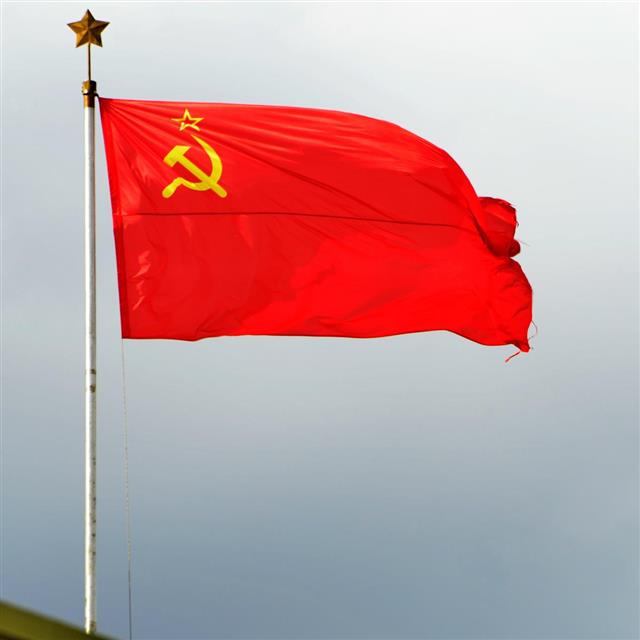
Known across the world for representing the ideals of communism, the flag of the Soviet Union has an interesting past. In this Historyplex article, we shall look at some interesting facts, such as its history, and the meaning and significance behind the symbols of the flag of the Soviet Union.
|
Did You Know?
Many historians have theorized that the hammer and sickle design of the Soviet Union flag was influenced by the crook and flail that were held by Egyptian pharaohs in a similar crossed manner, as depicted on the sarcophagus. |
The flag of the Soviet Union was the official national flag of the state from 1923 to 1991. It was inspired by the struggles of the common man during the brutal Russian Revolution of 1917. Today, internationally, it is considered as the symbol of communism.
Flag Design
The design of the flag of the Soviet Union has a solid red field, with a unique golden emblem of a crossed golden hammer and sickle, and a gold-bordered red star above this in the upper hoist corner. Officially, the back of the flag is just a red field. However, the flags were usually weaved through, which meant that the symbols would appear on the other side in the reverse order.
Measurements:
- The height-to-length ratio of the flag is 1:2
- The hammer and sickle come in a square, whose sides are ¼ of the flag’s height. The tip of the sickle is to be in the upper part of the square, while the handles of the hammer and sickle should be in the bottom corners of the square.
- If a circle was drawn around the tips of the five-point star, its diameter would be ⅛ the flag’s height.
- The distance from the flagstaff to the center of the hammer, sickle, and star is ⅓ the height of the flag.
- The distance from the top of the flag to the center of the star is ⅛ the flag’s height.
Flag Meaning
So what did the Soviet Union flag represent? Although the color red has always had positivity attributed to it in Russian culture, in the Soviet Union flag, the red field symbolizes the blood of the workers and farmers that was spilled during their struggle for liberation in the 1917 Russian Revolution, by honoring the red flag of the Paris Commune of 1871.
The hammer symbolizes urban industrial workers, while the sickle symbolizes agricultural workers, who together as the working-class form the Soviet state. The golden border of the red star represents the life and energy from the sun, filled with the sacrifices of the Russian people. The five points of the star indicate the five known continents of the time, where the revolution was to spread. The star also represented the communist party, and its position over the sickle and hammer symbolizes its leadership over the working classes, in bringing them together to build communism.
Flag History
Initially, during the Russian Revolution of 1917, the Bolsheviks considered a plain, red flag, to bring together the working class of the nation against the autocratic government. This flag was commonly associated with socialist movements all across Europe. However, after Lenin and Marx became victorious, the flag started to have communist overtones. To this end, the first red Soviet flag with the hammer and sickle was adopted in December 1922, at the First Congress of Soviets of USSR. In 1955, the flag was made official after a few minor changes on the hammer’s handle and the sickle’s shape. In 1980, a final was made, in which the red color was changed into a lighter shade. This flag remained the official national flag till the breakup of the Soviet Union on December 25, 1991, where it was changed to the present day tricolor.
Other Facts About the Flag
- Initially, while forming the SFSR (Soviet Federative Socialist Republic) Vladimir Lenin and other members of the new government considered including a sword in the flag, but the idea was rejected, as it was thought that the symbolism was too aggressive.
- The first draft of the Soviet flag was to have an unusual ratio of 4:1. This was later changed to the more familiar 2:1 ratio.
- The Soviet Union was the first nation with a socialist government, and the Soviet flag inspired several other countries which aspired for similar governance. The national flags of many nations, such as Afghanistan, Mongolia, Congo, People’s Republic of China, Albania, Angola, Korea, and Vietnam were inspired by the Soviet flag, and had a lot of similarity between them.
Though the flag of the Soviet Union may look like a basic combination of colors and symbols, each color and shape on it had a deep meaning, and meant a lot to the people of the time. Although it is not in use as a national flag today, it continues to inspire people and movements with similar ideologies.



